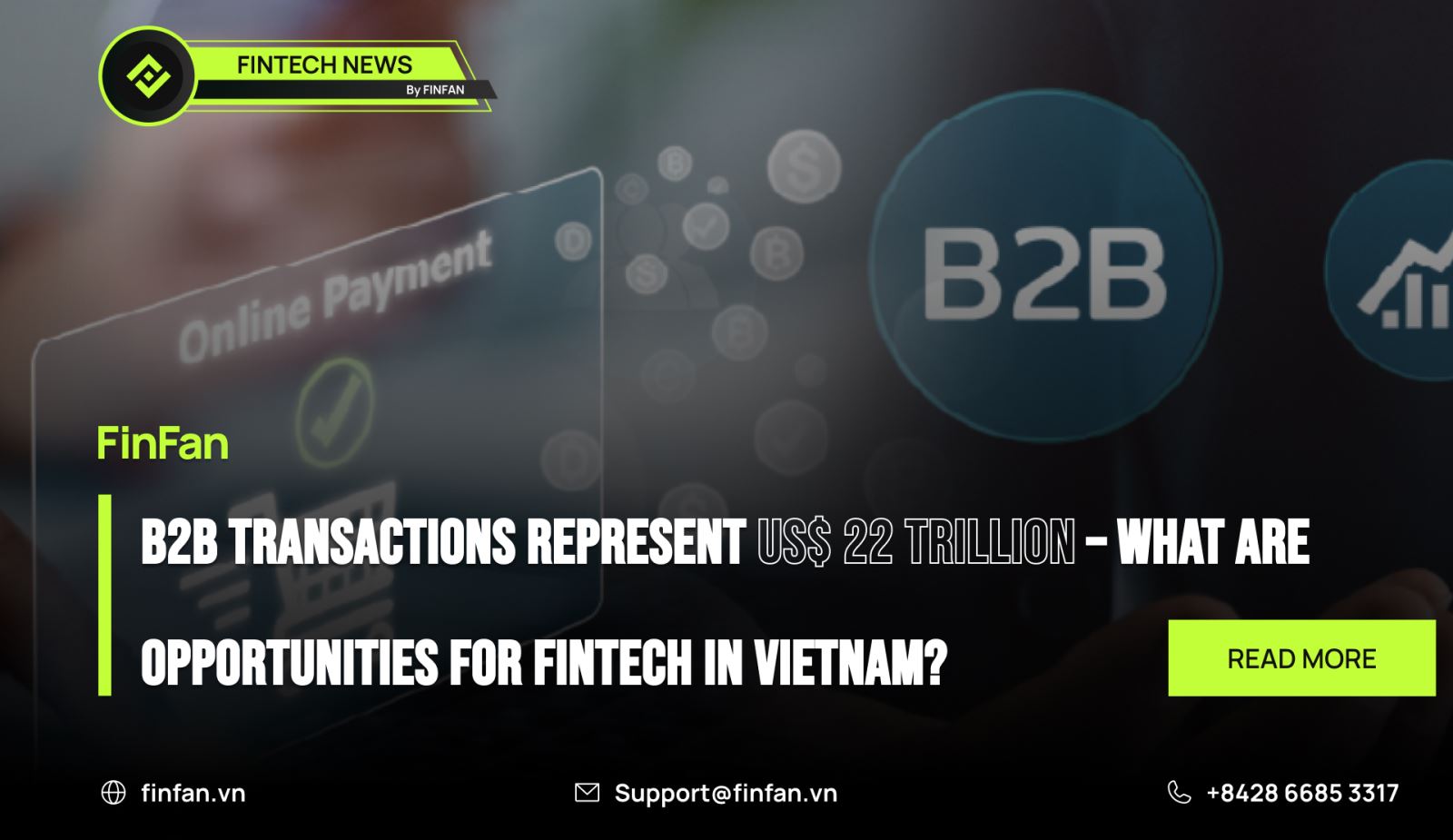B2B Transactions represent US$ 22 trillion – What are opportunities for fintech in Vietnam?

The latest report from Fintech News Singapore shows us that B2B transactions reached US$ 22 trillion in 2022. How can Vietnamese fintech companies take this chance to improve their services and grow faster? Let's find out with FinFan in this article.
How do the B2B transactions represent this number?
Although the global economy has suffered a double crisis after the COVID-19 pandemic, this number in the report shows us the positive sign of B2B transactions and the economic growth in the world for 2 or 3 years later.
How can businesses do that? It comes from 2 reasons:
The development of remittance technology
With the industrial revolution 4.0, remittance technology has also grown. Many new apps and websites have been established to help both senders and receivers better experience when they can now only with 3 or 4 steps remit money from one country to another.
This powerful step has greatly aided in solving the old pain-points of remittances are slow transactions’ process, high intermediary fees, and poor security.
Moreover, remittances can help many people in developing countries to overcome poverty; and this money can contribute to solving a number of economic problems of these countries as they contribute significantly to the state budget and the development of a number of businesses.
Read more:
. Examples of remittances in developing countries
The potential of cross-border B2B payments market
With the emergence of COVID-19 and the dual economic crisis, these remittance companies have been expanding to B2B payments because of the potential of cross-border e-commerce.
Nowadays the biggest e-commerce exchanges like Alibaba, Amazon, eBay, etc. have been planning to expand their markets and make it possible for distributors and merchants to interact and transact with one another on a global scale.
*Forrester estimates that cross-border shopping made up 20% of e-commerce in 2022, with sales reaching US$627 billion. Amazon, eBay, and Alibaba are three prominent marketplaces for shopping cross-border. Cross-border sales are said to account for nearly 25% of third-party units sold on Amazon, the market research company estimates.
Business-to-business (B2B) is another fast-growing e-commerce segment, with the B2B cross-border payments market expected to grow 120% by 2030 and account for US$22 trillion in market size, FXC Intelligence projects.
E-commerce sales are expected to grow this year onwards, projected to account for 20.8% of total retail sales and 24% of total retail sales by 2026, data from Insider Intelligence show.
Booming cross-border e-commerce activity is introducing new opportunities for remittance companies to tap into rising demand for seamless, safe and transparent B2B cross-border payment capabilities.*
*Sourced by Fintech News Singapore
What are the opportunities for fintech in Vietnam when B2B transactions represent US$ 22 trillion?
Vietnam is a developing country with the integration of technology comes very quickly. Up till now, Vietnam has also developed a market for the well-known and highly developed capital payment techniques used in industrialized nations.
Some Vietnamese fintech companies are increasingly proving their capabilities when becoming the unicorn of the whole region like MoMo, Timo, VNPay, Zalo Pay, etc.
Their development gives users a more excellent experience of currency and commodity exchange not only in the local market.
For instance, the handshake between MoMo and Western Union has ushered in a new age for both domestic and international business operations.
Other noteworthy collaborations include Remitly, Paysend, and Sentbe working with FinFan to connect with important local e-wallets in Vietnam including Zalo Pay, MoMo, and VNPay, which is also a significant advancement in technology. Foster international commerce cooperation and find worldwide solutions to the issues associated with cross-border remittances.
Read more:
With the prediction that the cross-border B2B payment market will reach USD 22 trillion by 2030 as indicated in the above report, the fintech market in Vietnam will grow even stronger when:
E-commerce giants have been pushing the market into Vietnam
The import and export of goods from other countries to Vietnam or vice versa has been growing strongly as Vietnamese businesses always want to find ways to push Vietnamese goods out of their home borders.
In addition, as technology and the internet have advanced, it has aided major businesses like Alibaba, Amazon, and eBay in promoting trade in rising areas like Southeast Asia, particularly those with a young population, like Vietnam.
To do this, large corporations must work with local fintech partners to offer an API system that connects international money flow channels with Vietnam.
This is most likely a fantastic opportunity for new businesses in this industry. If this chance is taken advantage of, perhaps more unicorns will start to appear on the Vietnamese market in the future.
Another form of payment that is also worthy of attention today is payment using blockchain and cryptocurrency. The parties involved in this kind of payment will gain when it encourages a quicker and less expensive payment process.
Moreover, by the end of 2022, Vietnam had the highest rate of cryptocurrency usage globally. It also shows the strong development of Vietnam's fintech industry compared to the region and the world. However, this payment method needs a long time for the Vietnamese government to approve (if the Vietnam central bank digital currency is born).
In conclusion, when the total amount of cross-border business transactions rises to $22 trillion by 2030, the development prospect for the fintech market in Vietnam is still enormous. Vietnamese fintech companies must constantly update their technology and discover new ways to collaborate with foreign partners in order to take advantage of market prospects.